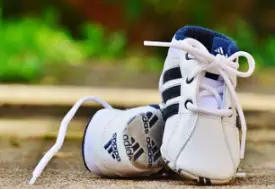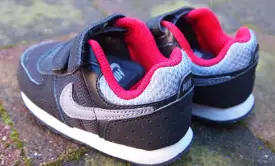best baby shoes
AUTHOR: Marc Mitnick DPM home --> best baby shoesTwo questions always asked of me, and I am sure most podiatrists and pediatricians, is when should my baby start wearing shoes and what type of shoe should they be wearing?
For the sake of this discussion lets assume your baby is full term, healthy, with normal development and no neurological issues.

|
Most babies will start walking around twelve months of age although there are instances where some start walking as early as five months of age.
I have always been a believer as I think most experts are, that until a baby is actually walking, or even standing by balancing themselves with support, they should not be in shoes but simply either in socks for warmth, or barefoot. Even though your young child may look more "complete" in shoes particularly if you are outside, shoes at a very young age can be detrimental to the growth of the foot. Quite simply, the possible constriction of the shoe may hinder development of the foot even if the youngster is not yet walking. Initially, once your child starts to walk, the type of shoe to be worn has to be thought out.
Baby shoes come in various flexible soles ranging from very stiff to very flexible. When your young child first starts to walk it is not just a matter of one foot moving forward, followed by the other, but additionally it becomes a necessity for the young walker to get a "feeling" for the ground underneath them. This is known as proprioception and it helps in creating a normal gait as well as a better sense of balance.
As a side note, many diabetics lose their sense of proprioception as a result of their disease, and this creates problems with the breakdown of their feet and their balance.
what is the best course for the new walker
So now that your child has begun to walk should they be in shoes all day or should they still be without shoes. I think the best advice is a combination of shoes at certain times and without shoes at other times. Obviously if your child is going outside, shoes should be mandatory but at home going without shoes is probably a better idea.
The reason for this is that being barefoot gives your child the best chance of developing proprioception. .

|
When it comes to choosing the best shoe for your child and I should point out that price alone does not determine the best shoe, you want to look for a shoe with a very flexible sole. Why a flexible sole? Simply stated, a flexible sole compared to a more rigid sole allows the foot to plantar load on the ground. In other words to adapt to the the terrain as the foot hits the ground. In general, walking around the house the floor surface is fairly even and flat, but if your child is outside say in the park or playground, the ground is uneven and as the foot hits the ground, the child needs to get a "feel" for the difference in terrain and then adapt to it. A flexible soled shoe results in more plantar loading (moving in response to the ground) then would a rigid soled shoe.
what research says about the best baby shoes
A study(1) was performed to test two hypotheses. The first was what are the structural differences across pediatric shoe design, and the second was to determine if these differences affect plantar loading during ambulation in the developing child.
Various shoes were tested ranging from very rigid soles to very flexible soles. Children differ from adults in that they have low body mass and low plantar pressure meaning their feet do not make much of an impact when hitting the ground. In order to maximize the plantar pressure, a more flexible soled shoe is required and this was ascertained in this study.
There is always the question of since almost all new walkers excessively pronate (feet flatten out), do we not want a more rigid shoe to control pronation? And yes, rigid shoes do control pronation better then flexible shoes, however, since rigid shoes reduce plantar load pressures and proprioception, they are not ideal in the development of the young foot. It is also worth mentioning that most children develop an arch as they mature and thus the end of flat feet.
In summary, as your child begins to walk, a combination of soft soled shoes as well as walking barefoot gives your child the best chance to develop balance and a normal gait. As mentioned, all children are flat footed as they begin to walk and this resolves in the majority of cases. If you are concerned at all about the development of your child's feet, a visit to a podiatrist might not be a bad idea.
For a discussion on children's shoe selection from Sole fit shoe fitters, click here
(1)Effect of Shoe Flexibility on Plantar Loading in Children Learning to Walk Hillstrom HJ, Buckland MA, Slevin CM, Hafer JF, Root LM, Backus SL, Kraszewski AP, Whitney KA, Scher DM, Song J, Furmato J, Choate CS, Scherer PR (Hospital for Special Surgery, New York, NY: Temple University, Philadelphia, PA; Samuel Merritt University, Oakland, CA)
Journal American Podiatric Medical Association. 2013:103(4):297-305
Want more information? CLICK HERE


Recent Articles
-
Vitamin D impact on health
Feb 06, 23 07:17 PM
Researchers are suggesting that the effectiveness of Vitamin D in fighting and preventing disease is predicated on a persons body mass index (BMI). The thinner the person the greater the positive impa… -
Foods to speed up healing
Feb 01, 23 02:41 PM
One of the best ways to help yourself heal faster after surgery is to eat well. Getting the proper nutrition will provide your body with the essentials it needs to promote healing. Here is a suggestio… -
Cancer and Type 2 Diabetes
Jan 25, 23 04:52 PM
An article revealing that older type 2 diabetics have a higher incidence of cancer then non-diabetics. It is suggested that cancer may surpass CVD as the number one cause of death in older diabetics. -
Does glucosamine or MSM reduce arthritis pain?
Jan 22, 23 01:41 PM
A good review of the possible benefits to taking glucosamine, chondroitin or MSM for arthritis. Always beware of the possible side effects of over the counter supplements. -
shin splints
Jan 18, 23 05:12 PM
A great review on the various causes of shin splints, along with treatment options. -
Whats new in skin cancer?
Jan 15, 23 08:32 PM
A presentation of newer skin protection combinations in an effort to better protect the skin from the hazards of sun exposure. -
Causes and risk factors of warts
Jan 14, 23 05:02 PM
A good review of the causes of warts and protective measures you can take to prevent developing them. -
Do chronic wounds need to be dressed daily?
Jan 11, 23 02:18 PM
Because of supply chain shortages as well as staffing shortages particularly during the pandemic, many institutions extended the time between dressing changes for chronic wounds. Is this really the be… -
Food choices that raise your risk of type 2 diabetes
Jan 08, 23 10:07 AM
A good review of how blood sugars can become elevated and the harm that can do. Certain food groups have a tendency to raise your blood sugars and should be avoided. -
Outcome stats from Scarf bunionectomy
Jan 03, 23 03:04 PM
The Journal of Foot and Ankle Surgery recently reported a meta analysis of outcomes in 1583 Scarf bunionectomies that met their inclusion criteria. Adverse events did not seem to be any better or wors…